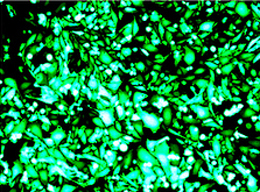Research Abstract
ミリメートル液滴の衝突はDNAおよびタンパク質の細胞への導入を誘導する
Collision of millimeter droplets induces DNA and protein transfection into cells
2012年2月28日 Scientific Reports 2 : 289 doi: 10.1038/srep00289

毒性が無く簡便なトランスフェクション法は、バイオテクノロジーで利用される現代の技術にとって重要である。最近我々は、細胞株、細菌やニワトリ胚においてエレクトロスプレー法がDNAの細胞への導入に応用できることを報告した。しかしながら、細胞への導入効率は約2%にすぎなかった。この導入効率を改善するために、スプレーする液滴の物理的性質をさまざまな異なる方法で研究した。我々は、導入する物質を加えた培養細胞に対して高い伝導度をもつ液体の液滴をエレクトロスプレーすることによって、DNAやタンパク質といった材料の生細胞への導入に非常に効率的な技術(30~93%)を報告する。電気伝導度は、導入効率に対して大きな影響をもつ。対照的に、細胞へ導入した材料の分子量、エレクトロスプレー液のイオンの種類、そして浸透圧は導入効率に影響しない。物理的解析により、ミリメートルの大きさの液滴と細胞の衝突が細胞内への取り込みを活性化することを明らかにした。
- 三菱ガス化学株式会社
- 埼玉大学大学院理工学研究科
Nonperturbing and simple transfection methods are important for modern techniques used in biotechnology. Recently, we reported that electrospraying can be applied to DNA transfection in cell lines, bacteria, and chicken embryos. However, the transfection efficiency was only about 2%. To improve the transfection rate, physical properties of the sprayed droplets were studied in different variations of the method. We describe a highly efficient technique (30–93%) for introduction of materials such as DNA and protein into living cells by electrospraying droplets of a high conductivity liquid onto cells incubated with the material for transfection. Electric conductivity has a sizable influence on the success of transfection. In contrast, molecular weight of the transfected material, types of ions in the electrospray solution, and the osmotic pressure do not influence transfection efficiency. The physical analysis revealed that collision of cells with millimetre-sized droplets activates intracellular uptake.

